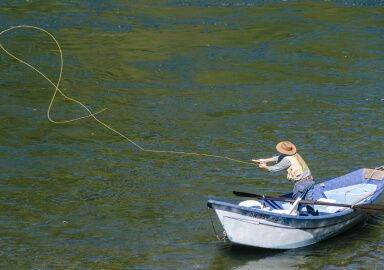Garfish
Garfish are long, thin, streamlined marine fish found in the surface waters. Several species of garfish are found all over the globe.
View 10 listings
10
listings
–
price starting from
2
countries
–
to the nearest trip
Where and When?
Tropical garfish are found around the globe in areas with appropriate climate, and are most often caught round Australia, South Africa and along the western seaboard of the Americas, as well as the eastern seaboard from New Jersey to Brazil. European garfish are a more temperate species found around the European shoreline from Scandanavia to the Mediterranean Sea and into the Black Sea. Both species have areas of greater and lesser abundance within their range, probably due to local conditions. All garfish seem to remain in the top couple of meters of the marine environment whether they are close inshore or in mid ocean. They can be found very close to shore, around rocky outcrops or in open water often associated with floating vegetation or detritus. As fully optic feeders they are mostly caught during daylight and, in winter, are most active nearer the middle of the day while in summer they are active all day. They can be caught throughout the year in most areas but the European garfish is much less active in winter.
About Garfish
Garfish, also called needlefish, crocodilefish or houndfish, are members of the family Belonidae. All species are very similar in appearance and behaviour and fill the same niches in different localities. They are all extremely elongate and streamlined, with large eyes and very long jaws fitted with an impressive array of sharp, pointed teeth. They all cruise in the upper few metres of the marine environment and their colours, electric blue/green above and much lighter below, help them to blend completely into the background. They feed mostly on small fish and undergo local migrations. Spawning takes place offshore and eggs are found attached to floating debris. Of the two main species, Tylosurus crocodilus, the tropical garfish, houndfish or crocodilefish, is the larger species and has a wide distribution. It can attain 150 centimeters ( 40,9 in.) and a mass of 6.4 kilograms ( 14,0 lbs.) while the European garfish or needlefish (Belone belone) is more localised and reaches only 105 centimeters and 1.4 kilograms ( 3,1lbs.).
How to Catch?
Most garfish are caught from the shore, be it beach, rocks or pier. In reality, however, few anglers actively target garfish, but, if they are around and other species are not co-operating, they can give excellent sport. Similarly, with boat fishing, if garfish are seen and the right tackle is available, then they can be targeted to good effect. Due to the normally limited size, light tackle is best and, while fly-fishing can give results, lure or bait fishing is usually more productive. The fighting ability of garfish far exceeds that of many heavier species. They routinely leap high out of the water and thrash around, even after being landed or boated. Some anglers report severe cuts from their extremely sharp teeth that can also make landing them without a wire trace problematic. The best baits are probably artificial lures but their very bony jaws make setting a hook difficult. If possible, casting small live bait or dead fish near them is probably the best approach. Any bait or lure more than two meters below the surface will probably not catch garfish. Despite their smallish size, garfish can provide excellent sport, and it is a real challenge to hook, play and safely land a large garfish.






